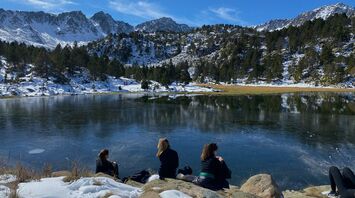Andorra: The Largest Country Without an Airport – A Gateway to Seclusion

Tucked away in the eastern Pyrenees between France and Spain, Andorra is a country that defies expectations. While many visitors may be drawn to this picturesque principality for its stunning mountain landscapes and world-class ski resorts, one surprising fact often comes as a shock: Andorra is the largest nation in the world without an airport. For a country covering 181 square miles and welcoming millions of tourists annually, the absence of a national airport poses an intriguing paradox in the modern age of travel.
A Landlocked Haven With No Air Access
Despite its small size, Andorra’s geographical challenges make it difficult to establish a functioning airport. The country’s rugged terrain, dominated by the towering peaks of the Pyrenees, leaves little room for large-scale infrastructure like runways. While this might seem like a drawback for a country that thrives on tourism, the lack of an airport has only contributed to Andorra’s unique allure—a sense of seclusion that draws those seeking an escape from the hustle and bustle of everyday life.
Travelers looking to reach Andorra by air typically fly into airports in nearby France or Spain, with the closest being Andorra-La Seu d'Urgell Airport, located about 12 miles from the Andorran border. From there, travelers must rely on road transport to reach the heart of the principality. Alternatively, many visitors opt to fly into larger hubs such as Barcelona or Toulouse, both of which are roughly a three-hour drive from Andorra’s capital, Andorra la Vella.
The Journey as Part of the Experience
For those who make the trip, the journey to Andorra becomes an integral part of the adventure. Winding roads take travelers through dramatic mountain passes, offering sweeping views of snow-capped peaks, verdant valleys, and pristine rivers. In a world where air travel is often synonymous with convenience and speed, the absence of direct flights encourages a more leisurely approach, allowing visitors to appreciate the scenic landscapes along the way.
Many who visit Andorra find that the effort required to reach this hidden gem only heightens its charm. The road to the principality winds through some of the most breathtaking parts of the Pyrenees, giving travelers an intimate introduction to the region’s natural beauty before they even arrive. Whether traveling by car, bus, or even by train to nearby French or Spanish stations, the experience of reaching Andorra sets the tone for the peaceful retreat that awaits.
A Ski Destination Like No Other
Andorra’s economy is heavily reliant on tourism, with its ski resorts playing a pivotal role in drawing visitors from across Europe and beyond. Grandvalira, the largest ski area in southern Europe, spans over 125 miles of slopes, making it a magnet for skiing enthusiasts. The absence of an airport has not deterred this influx; rather, it has fostered a reputation for exclusivity and pristine natural settings. Skiers and snowboarders who make the journey are rewarded with world-class facilities and some of the most reliable snowfall in the Pyrenees.
But winter sports are not Andorra’s only draw. The country offers a wealth of outdoor activities year-round, including hiking, mountain biking, and climbing. For nature lovers, Andorra’s mountainous terrain provides ample opportunities for exploration and adventure. Visitors can hike to hidden lakes, trek through lush forests, or simply bask in the unspoiled beauty of the Pyrenean wilderness.
Duty-Free Shopping and Tax Benefits
In addition to its natural beauty, Andorra has long been a shopping haven thanks to its duty-free status. Visitors can take advantage of lower prices on luxury goods, electronics, and perfumes—making the trip even more worthwhile for those looking to indulge in some retail therapy. The country’s favorable tax laws also extend to residents, with Andorra offering some of the lowest tax rates in Europe, which has attracted expatriates and businesses alike.
However, while shopping is a popular pastime in Andorra, it’s the principality’s commitment to sustainable tourism that stands out. With its focus on eco-friendly development, Andorra is gradually positioning itself as a destination where nature and tourism coexist harmoniously. This emphasis on sustainability ensures that Andorra’s natural wonders remain protected for future generations, offering travelers a chance to enjoy its pristine environment with a light ecological footprint.
The Future of Andorran Travel
The lack of an airport has certainly shaped Andorra’s travel landscape, but there are ongoing discussions about whether the country will ever establish air connectivity. In recent years, there have been efforts to expand and modernize nearby Andorra-La Seu d'Urgell Airport, with hopes that it could eventually serve as a primary gateway for international flights. Proposals for small regional airports have also been floated, but the challenges posed by the country’s mountainous terrain remain a significant barrier to such projects.
For now, Andorra’s charm lies in its remoteness. The absence of direct flights has, in many ways, preserved its natural beauty and sense of tranquility. In an era where ease of access often leads to over-tourism, Andorra stands apart as a destination where the journey is part of the appeal, and where the untouched landscapes offer a rare opportunity for reflection and escape.



















